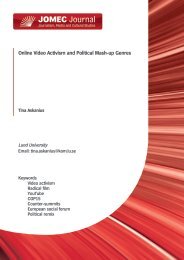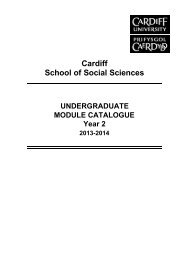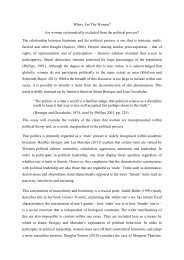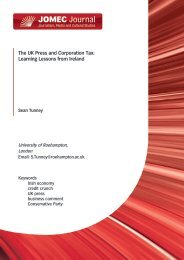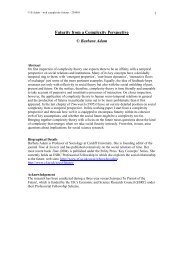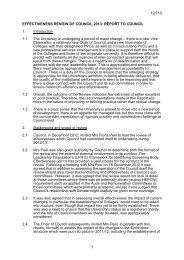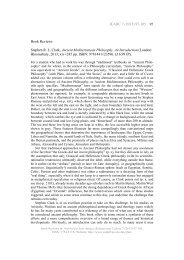APHRODITE IN PROCLUS' THEOLOGY - Cardiff University
APHRODITE IN PROCLUS' THEOLOGY - Cardiff University
APHRODITE IN PROCLUS' THEOLOGY - Cardiff University
You also want an ePaper? Increase the reach of your titles
YUMPU automatically turns print PDFs into web optimized ePapers that Google loves.
JLARC 3 (2009) 21-43 33<br />
chains mentioned a little bit later in the same song are, for Proclus, symbols of the<br />
forms of the sublunar world, which Hephaestos casts.<br />
Both gods need Aphrodite for their deeds, one to bring harmony and order to<br />
opposites, the other to bring perceptible beauty and shining clarity to his creation<br />
so that this world could be made into the most beautiful of sensible things.<br />
Aphrodite is present everywhere but Hephaestos “participates” to her in the mode<br />
of the higher realities. We find in this exegesis four different levels of demiurgy.<br />
There are two pairs: where Hephaestos manifests the higher and Ares the lower<br />
demiurgy. Hephaestos mode of participation in Aphrodite is hypercosmic and<br />
celestial, that of Ares encosmic and sublunar.<br />
Mythology conceals and reveals Hephaestos’ mode of action, saying that he takes<br />
Aphrodite as his spouse to observe the will of Zeus. Ares’ relation to the goddess is<br />
called adultery by the myths.<br />
In Remp. 1.141,26-142,5: τῷ μὲν γὰρ δημιουργῷ τῶν αἰσθητῶν κατὰ φύσιν ἐστὶν<br />
ἡ πρὸς τὴν καλλοποιὸν αἰτίαν καὶ συνδετικὴν κοινωνία, τῷ δὲ τῆς διαιρέσεως<br />
προστάτῃ καὶ τῆς ἐναντιώσεως τῶν ἐγκοσμίων ἀλλοτρία πώς ἐστιν ἡ τῆς<br />
ἑνώσεως χορηγὸς δύναμις· τοῖς γὰρ συναγωγοῖς τὰ διακριτικὰ γένη τῶν θεῶν<br />
ἀντιδιῄρηται. ταύτην τοίνυν τὴν τῶν ἀνομοίων αἰτίων σύμπνοιαν οἱ μῦθοι<br />
μοιχείαν προσειρήκασιν.<br />
For the maker of sensible things a coupling with the cause which creates beauty<br />
and binds things together is natural, whereas for the god, who oversees division<br />
and opposition in worldly things, for him the unifying force is somehow alien. The<br />
separating classes of the gods are directly opposed to the classes which are<br />
unifying. Because of this, the myths call a union of the different causes adulterous<br />
(translation mine).<br />
But this kind of union is also necessary for the cosmogony, “in order to bring<br />
opposites into harmony and so that the internal war of the world will end into<br />
peace.” 49<br />
At every level oppositon is the gift of Ares. On the celestial level it refers to the<br />
mutual strife between forms when they try to oust each other, while on the terrestrial<br />
level it refers to the struggle of the elements and forces. As Helios is the companion<br />
of Hephaestos in the production of universal forms, he denounces the intercourse<br />
of Ares and Aphrodite to Hephaestos. The chains of Hephaestos, by means of which<br />
he captures Ares and Aphrodite, are forces invisible to others and in using them<br />
Hephaestos “builds from the opposites of Ares and Aphrodite’s joining virtues a<br />
unified order, since becoming needs both of them.” 50<br />
Hephaestos’ chains are different in the celestial and the sublunar world. The<br />
former are indissoluble, while it is possible to loose the latter. Proclus also finds<br />
the word “chain” to be a uniting physical force in Plato’s Timaeus and this is<br />
49 In Remp. 1.141, 7-142, 7.<br />
50 In Remp. 1.142,17-19.<br />
Tuomo Lankila, ‘Aphrodite in Proclus’ Theology,’ in: Journal for Late Antique Religion and<br />
Culture 3 (2009) 21-43; ISSN: 1754-517X; Website: http://www.cardiff.ac.uk/clarc/jlarc




